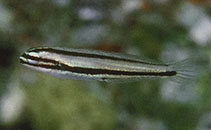Meiacanthus ditrema Smith-Vaniz, 1976
One-striped poison-fang blenny
Add your observation in Fish Watcher
| Native range |

|
| This map was computer-generated and has not yet been reviewed. |
| Meiacanthus ditrema AquaMaps Data sources: GBIF OBIS |
Upload your photos and videos
Pictures | Videos | Google imageMeiacanthus ditrema
Picture by Steene, R.
Pictures | Videos | Google imageMeiacanthus ditrema
Picture by Steene, R.
Classification / Names Nombres comunes | Sinónimos | Catalog of Fishes(Género, Especie) | ITIS | CoL | WoRMS | Cloffa
> Blenniiformes (Blennies) > Blenniidae (Combtooth blennies) > Blenniinae
Etymology: Meiacanthus: Greek, meion = less = lessen + Greek, akantha = thorn (Ref. 45335).
Etymology: Meiacanthus: Greek, meion = less = lessen + Greek, akantha = thorn (Ref. 45335).
Environment: milieu / climate zone / depth range / distribution range Ecología
marino asociado a arrecife; rango de profundidad 0 - 18 m (Ref. 58018). Tropical; 30°N - 22°S
Distribución Países | Áreas FAO | Ecosistemas | Ocurrencias, apariciones | Point map | Introducciones | Faunafri
Western Pacific: Moluccas and the Philippines east to Samoa, north to Ryukyu Islands, south to Rowley Shoals in Western Australia and the northern Great Barrier Reef and Tonga; Palau (Belau) in Micronesia.
Tamaño / Peso / Age
Short description Claves de identificación | Morfología | Morfometría
Espinas dorsales (total) : 5 - 6; Radios blandos dorsales (total) : 22 - 25; Espinas anales: 2; Radios blandos anales: 15 - 18. Males with long filaments from the tips of the tail (Ref. 48636).
Body shape (shape guide): elongated.
Body shape (shape guide): elongated.
Adults are found on reef slopes with large soft-coral communities (Ref. 48636). They form groups usually among gorgonians or black coral (Ref. 90102) in shallow protected reefs. Relatively common and broadly distributed. Feed on zooplankton. Oviparous. Eggs are demersal and adhesive (Ref. 205), and are attached to the substrate via a filamentous, adhesive pad or pedestal (Ref. 94114). Larvae are planktonic, often found in shallow, coastal waters (Ref. 94114). Minimum depth from Ref. 58018.
Life cycle and mating behavior Madurez | Reproducción | Puesta | Huevos | Fecundidad | Larva
Oviparous, distinct pairing (Ref. 205).
Main reference
Upload your references | Referencias | Coordinador : Williams, Jeffrey T. | Colaboradores
Myers, R.F., 1991. Micronesian reef fishes. Second Ed. Coral Graphics, Barrigada, Guam. 298 p. (Ref. 1602)
IUCN Red List Status (Ref. 130435: Version 2024-2)
Least Concern (LC) ; Date assessed: 28 March 2009
CITES
Not Evaluated
Threat to humans
Venomous (Ref. 1602)
Human uses
FAO - Publication: search | FishSource |
Más información
Trophic ecology
Food items (preys)
Composición de la dieta
consumo de alimento
Food rations
Despredadores
Food items (preys)
Composición de la dieta
consumo de alimento
Food rations
Despredadores
Population dynamics
Coeficiente del crecimiento para
Max. ages / sizes
Length-weight rel.
Length-length rel.
Length-frequencies
Mass conversion
Reclutamiento
Abundancia
Coeficiente del crecimiento para
Max. ages / sizes
Length-weight rel.
Length-length rel.
Length-frequencies
Mass conversion
Reclutamiento
Abundancia
Life cycle
Reproducción
Madurez
Maturity/Gills rel.
Fecundidad
Puesta
Spawning aggregations
Huevos
Egg development
Larva
Dinámica larvaria
Reproducción
Madurez
Maturity/Gills rel.
Fecundidad
Puesta
Spawning aggregations
Huevos
Egg development
Larva
Dinámica larvaria
Anatomy
Superficie branquial
Brain
Otolith
Superficie branquial
Brain
Otolith
Physiology
Body composition
Nutrients
Consumo del oxígeno
Tipo de natación
Velocidad de natación
Visual pigments
Fish sound
Diseases & Parasites
Toxicity (LC50s)
Body composition
Nutrients
Consumo del oxígeno
Tipo de natación
Velocidad de natación
Visual pigments
Fish sound
Diseases & Parasites
Toxicity (LC50s)
Genetics
Genética
Heterozygosity
heritabilidad
Genética
Heterozygosity
heritabilidad
Human related
Aquaculture systems
Perfiles de acuicultura
Razas
Ciguatera cases
Stamps, coins, misc.
Aquaculture systems
Perfiles de acuicultura
Razas
Ciguatera cases
Stamps, coins, misc.
Herramientas
Bio-Quiz | E-book | Guía de campo | Asistente para frecuencias de tallas | Herramienta de ciclo de vida | Mapa de puntos | Classification Tree
| Catch-MSY |
Special reports
Download XML
Fuentes de Internet
AFORO (otoliths) | Aquatic Commons | BHL | Cloffa | BOLDSystems | Websites from users | Check FishWatcher | CISTI | Catalog of Fishes: Género, Especie | DiscoverLife | ECOTOX | FAO - Publication: search | Faunafri | Fishipedia | Fishtrace | GenBank: genome, nucleotide | GloBI | Google Books | Google Scholar | Google | IGFA World Record | MitoFish | Otolith Atlas of Taiwan Fishes | PubMed | Reef Life Survey | Socotra Atlas | Árbol de la vida | Wikipedia: Go, búsqueda | World Records Freshwater Fishing | Zoobank | Expediente Zoológico
Estimates based on models
Preferred temperature (Ref. 123201): 25.7 - 29.3, mean 28.5 °C (based on 1738 cells).
Phylogenetic diversity index (Ref. 82804): PD50 = 0.5000 [Uniqueness, from 0.5 = low to 2.0 = high].
Bayesian length-weight: a=0.00575 (0.00253 - 0.01308), b=3.06 (2.86 - 3.26), in cm total length, based on LWR estimates for this (Sub)family-body shape (Ref. 93245).
Nivel trófico (Ref. 69278): 3.4 ±0.45 se; based on food items.
Resiliencia (Ref. 120179): Alto, población duplicada en un tiempo mínimo inferior a 15 meses (Preliminary K or Fecundity.).
Fishing Vulnerability (Ref. 59153): Low vulnerability (10 of 100).
Nutrients (Ref. 124155): Calcium = 196 [100, 373] mg/100g; Iron = 1.06 [0.61, 1.83] mg/100g; Protein = 18.2 [17.0, 19.3] %; Omega3 = 0.104 [0.054, 0.196] g/100g; Selenium = 21.9 [10.2, 50.3] μg/100g; VitaminA = 226 [75, 707] μg/100g; Zinc = 2.15 [1.38, 3.19] mg/100g (wet weight);




